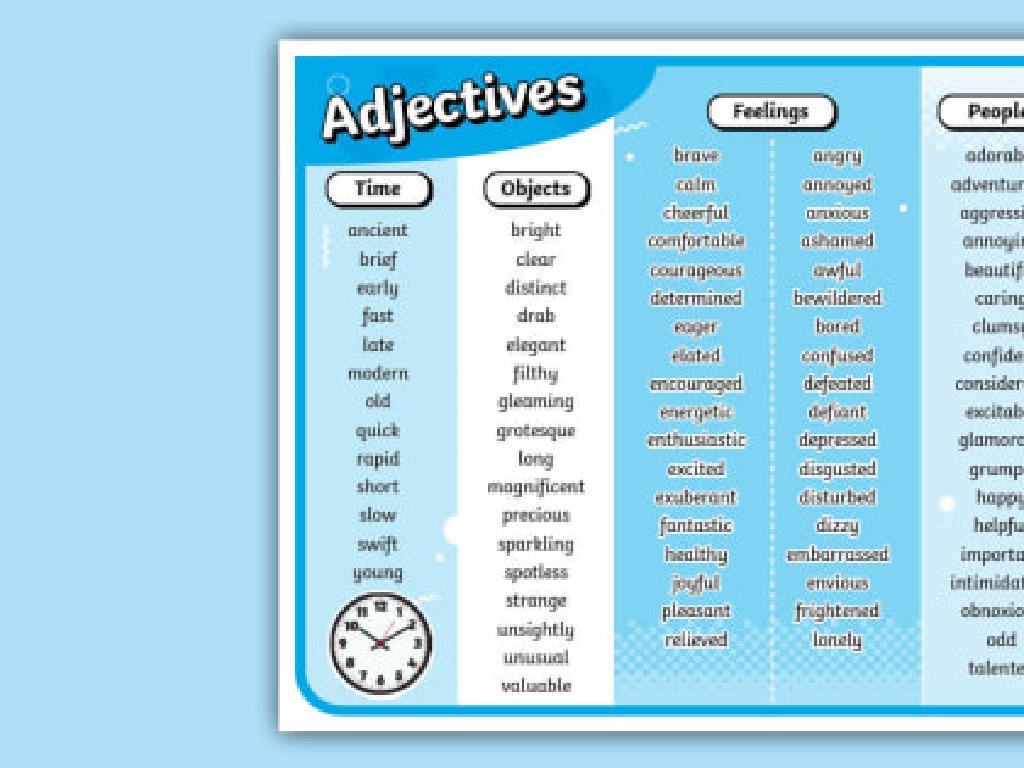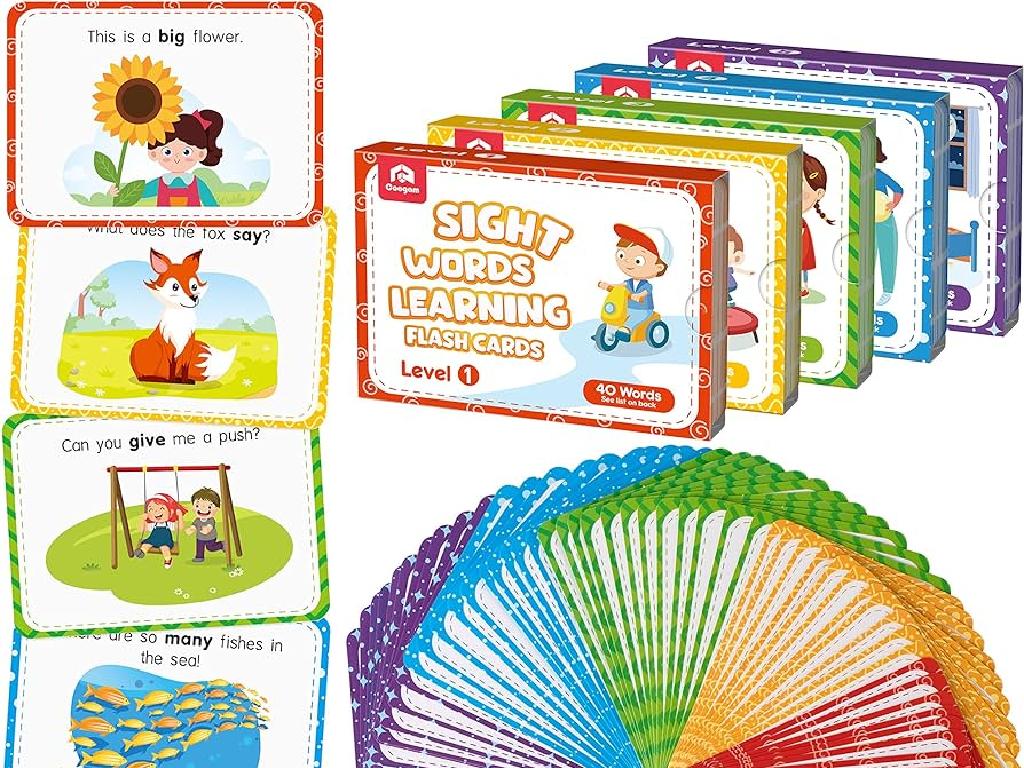Identify Representative, Random, And Biased Samples
Subject: Math
Grade: Seventh grade
Topic: Statistics
Please LOG IN to download the presentation. Access is available to registered users only.
View More Content
Introduction to Sampling in Statistics
– Understanding the power of sampling
– Sampling helps us study a part to understand the whole
– Defining what a sample is
– A sample is a subset of a population used for analysis
– Exploring the importance of sampling
– Accurate sampling leads to reliable statistical conclusions
– Recognizing types of samples
– Learn about representative, random, and biased samples
|
This slide introduces the concept of sampling as a fundamental technique in statistics, which allows us to analyze a part of a population to make inferences about the whole. Emphasize that a sample is a smaller, manageable version of a larger group. Discuss why sampling is crucial: it saves time, resources, and provides data for statistical analysis. Highlight that the reliability of statistical results depends on how well the sample represents the population. Introduce the terms ‘representative’, ‘random’, and ‘biased’ samples, setting the stage for a deeper dive into each type and their significance in data collection and analysis. Encourage students to think about examples of sampling in everyday life.
Understanding Types of Samples in Statistics
– Representative vs. Biased Samples
– Representative reflects whole population, biased does not
– Random Samples Explained
– Random samples rely on chance, no selection bias
– Identifying Sample Types
– Use clues like selection method to determine type
– Significance in Real-world Data
|
This slide introduces students to the concept of sampling in statistics, focusing on the differences between representative, random, and biased samples. A representative sample accurately reflects the characteristics of the population from which it is drawn, while a biased sample does not and may lead to incorrect conclusions. Random samples are selected purely by chance, minimizing the risk of bias. Teach students to identify the type of sample by looking at how it was selected. Discuss why the type of sample is crucial when collecting data to ensure that results are valid and applicable to the broader population. Provide examples of each type of sample and their implications in real-world scenarios, such as surveys and studies.
Understanding Representative Samples
– Define Representative Sample
– A sample that accurately reflects the population
– Importance of Diversity in Samples
– Variety in sample ensures all segments are included
– Characteristics of a Good Sample
– Must be randomly selected, unbiased, and sufficiently large
– Example: School Lunch Survey
– Surveying random students of all grades to decide new lunch items
|
This slide introduces the concept of representative samples in statistics, which are crucial for accurate data analysis. A representative sample mirrors the diversity and characteristics of the larger population, ensuring that every subgroup is proportionally included. Emphasize the importance of random selection to avoid bias and the need for a sample size that is large enough to be statistically significant. Use a relatable example, such as surveying a diverse group of students to decide on new school lunch items, to illustrate how a representative sample can lead to decisions that reflect the preferences of the entire student body. Discuss how this method prevents skewed results that could arise from only surveying a specific group.
Understanding Random Samples in Statistics
– Defining a random sample
– Each member of the population has an equal chance of being selected.
– Methods for random sampling
– Use of lottery system or computer-generated random numbers.
– Real-world random sampling example
– Surveying every nth person entering a store to gauge customer satisfaction.
|
This slide aims to clarify the concept of random sampling, which is a cornerstone of statistical analysis. A random sample is one where each member of the population has an equal chance of being included, thus ensuring the sample’s representativeness. Discuss various methods to achieve randomness, such as drawing names from a hat, using a random number table, or employing software that generates random selections. Provide a concrete example, like surveying visitors at a mall at regular intervals, to illustrate how random sampling works in a real-world scenario. Emphasize the importance of randomness in avoiding bias and making sure the sample accurately reflects the larger population.
Understanding Biased Samples in Statistics
– What is a biased sample?
– A sample that doesn’t represent the whole population.
– Impact of bias on data
– Skewed results can lead to incorrect conclusions.
– Recognizing sample bias
– Look for samples that exclude certain groups.
– Real-world example of bias
– Election polls excluding certain demographics.
|
This slide aims to educate students on the concept of biased samples in statistics. A biased sample occurs when the selection process favors certain outcomes over others, failing to accurately represent the entire population. It’s crucial for students to understand that biased samples can significantly affect the validity of data, leading to misleading results and potentially incorrect conclusions. To illustrate this, discuss how election polls might be biased if they only survey certain demographics, thus not capturing the full spectrum of voter opinions. Encourage students to think critically about how samples are chosen and to question the reliability of statistical data presented to them.
Comparing Different Types of Samples
– Visuals of sample types
– See how representative, random, and biased samples differ visually.
– Criteria for representative samples
– Must reflect the whole population accurately to be representative.
– Identifying biased samples
– Biased samples favor certain outcomes or groups.
– Activity: Sample type scenarios
– Analyze scenarios to determine sample types.
|
This slide aims to help students visually differentiate between representative, random, and biased samples. A representative sample accurately reflects the diversity of the population, while a biased sample skews results by favoring certain outcomes or groups. During the activity, present students with various scenarios and ask them to identify the type of sample used. For example, if a survey about school lunch is only given to the soccer team, is it representative or biased? This exercise will enhance their critical thinking skills and understanding of how sample types can affect the validity of data in statistics.
Class Activity: Sampling Experiment
– Break into small groups
– Design a survey together
– Collect data using varied methods
– Use methods like random, voluntary, or convenience sampling
– Discuss and identify sample types
– Share findings in class to learn about each sample type
|
This activity is aimed at helping students understand the different types of sampling methods by practicing them. Divide the class into small groups and have each group design a survey on a topic of their choice. Each group should use a different sampling method to collect data: one could use random sampling, another could use a convenience sample, and so on. After data collection, reconvene and have each group present their findings and discuss the type of sample they used. This will help students identify the characteristics of representative, random, and biased samples in a practical context. Possible activities could include surveying students in different grades, teachers, or people in the community, depending on the chosen method.
Understanding Samples: Recap & Homework
– Recap sample types importance
– Homework: Survey sample analysis
– Find a survey from recent news articles
– Identify sample type used
– Determine if it’s representative, random, or biased
– Reflect on sample validity
– Consider how the sample type affects the survey’s conclusions
|
This slide aims to consolidate the students’ understanding of the different types of samples in statistics and their significance in drawing conclusions from data. The homework assignment is designed to apply their knowledge to real-world scenarios, encouraging critical thinking about how data is collected and reported in the media. Students should look for surveys in news outlets, identify the type of sample used, and reflect on whether the sample provides a valid representation for the conclusions drawn. This exercise will help them recognize the importance of sample selection in the interpretation of statistical results and the potential for bias in reported data.






